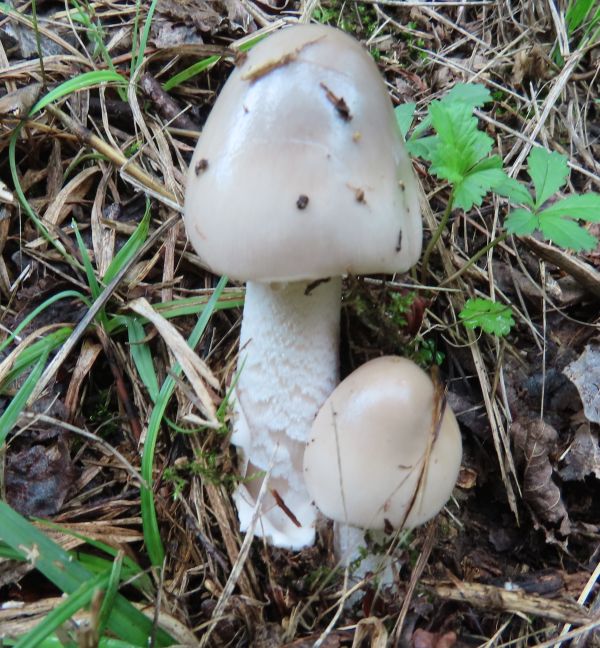Trees Birds Mammals Fish Amphibians Reptiles
Wild Algarve
Bookshop
Your 2,500-page Wildlife Window on the World Wide Web

818 Wildflower Pages

850 Fungi Pages

223 Bird Pages

72 Fish Pages

227 Insects Pages

45 Tree Pages

6 Amphibian Pages

6 Reptile Pages

32 Mammal (incl. bats) Pages

Flyfishing Guidance

Wales' Top Nature Sites

World's Top Nature Sites
Previous Next
Thank you...
Our website is kept online by income from sales of our books and by kind donations from site visitors. Sincere thanks to all of you who helped us to keep First Nature freely online in 2025 without intrusive pop-up advertising. Pat and Sue
A good year for woodland fungi...
In Britain and Ireland as well as most parts of mainland Europe, 2025 is a fascinating year for fungi enthisiasts.

In September we found these splendid Grisettes, Amanita vaginata, on a woodland edge. They were being kept company by more than a dozen others!
Fungi are with us throughout the year...
...but July to November is the cream of the season, with so many fascinating species to look out for and learn about.
This pictorial guide covers 26 major genera/groupings and nearly 1000 pages about the most beautiful, weird and wonderful mushrooms, toadstools and other kinds of fungi commonly found in woodland and grassland habitats in Britain and Europe. The pictures link to detailed, illustrated identification pages about each species.
A trilogy of thrillers for the long dark evenings
Available now, all three books in the Winding River Mystery series by Pat O'Reilly are now available both as paperbacks and as ebooks Amazon in the UK and worldwide. Here's a link to the first book, Dead Driift...
As with all First Nature books, all proceeds from sales help cover the cost of keeping the First Nature website online.
Microscopy for Amateur Mycologists
It's amazing how much more you can learn about fungi if you have access to a microscope. Our no-jargon Online Guide to Mushroom Microscopy has all the essential information about choosing and using a compound microscope, selecting chemical stains, preparing slides etc to help you get started.
There are also examples of the microscopic 'characters' cited in identification keys. More details...
Summer Spectacular
From June to October, waysides and roadside verges are brightened by the beautiful orange-lipped yellow flowers of Common Toadflax, a member of the Plantaginaceae family. These snapdragon-like flowers are just exquisite!

Blue is not a colour normally associated with mushrooms, but there are a few striking blue species. Pictured here is one that makes itself obvious in another way too: the Aniseed Funnel Clitocybe odora can be found by 'following your nose'! See our Sortable Fungi Index for pictures and identification details for nearly 800 fascinating fungi species.
Note on Terminology: We use the term wildflowers where some people still write wild flowers as two words; however, whether you prefer wildflowers or wild flowers we are sure you will find many flower species of interest in our wildflower pages. Similarly with fungi: some people call all edible fungi mushrooms, using the term toadstools to denote inedible of poisonous fungi. Others reserve the term mushroom for Agaricus species such as field mushrooms. We use the term mushroom to describe any cap-and-stem fungi, whereas brackets, crusts, puffballs and other non-mushroom-shaped types of fungi are referred to simply as fungi. To many people, wildlife means animals such as birds, mammals and insects. Are wildflowers (or wild flowers) wildlife? They are living things, and part of Nature; we therefore use wildlife to imply all living creatures, whether animals (including mammals, birds, insects, reptiles, amphibians, fishes etc), plants such as wildflowers, trees, mosses and other 'lower plants' as well as fungi, lichens and slime moulds.
Help more people learn about and enjoy nature...
We are always pleased to receive your suggestions, corrections, pictures and donations to help keep First Nature online and free from intrusive adverts...
Top of page...